|
FAQs about Naso lituratus Trauma
FAQs on Lipstick Tang Disease:
Lipstick Tang Disease 1, Lipstick Tang Disease 2, Lipstick Tang Disease
3, Lipstick Tang Disease
4, Lipstick Tang Disease ,
FAQs on Lipstick Tang Disease by Category:
Diagnosis, Environmental,
Nutritional, Social,
Pathogenic
(plus see
Tangs/Rabbitfishes &
Crypt), Genetic,
Treatments
Related Articles: Lipstick Tangs, Naso
Tangs, Surgeonfishes/Tangs/Doctorfishes and Marine
Aquariums,
Related FAQs: Lipstick Tangs 1, Lipstick Tangs 2, & Lipstick Tang Identification, Lipstick Tang Behavior, Lipstick Tang Compatibility, Lipstick Tang Selection, Lipstick Tang Systems, Lipstick Tang Feeding, Lipstick Tang Reproduction, & Naso Tangs 1, Naso Tangs 2, Naso
Tangs 3, Naso ID, Naso Behavior, Naso Compatibility, Naso Selection, Naso Systems, Naso Feeding, Naso Disease, Naso Reproduction, Surgeons In General, Tang
ID, Selection,
Tang
Behavior, Compatibility, Systems, Feeding, Disease,
|
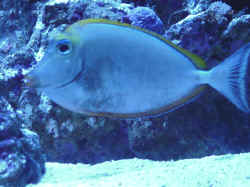
See the fingerprints?
|
Surgeonfishes: Tangs for Marine Aquariums
Diversity, Selection & Care
New eBook on Amazon: Available here
New Print Book on Create Space: Available
here
by Robert (Bob) Fenner |
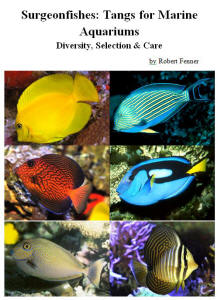 |
Juvenile Naso tang - hiding and not eating
7/15/16
Hi! I need your advice (tank size 120g including sump, 5ft long,
<See WWM re Naso lituratus... needs more room than this>
ammonia 0, nitrate 7, phosphate 0-ish) (fish : 3 small Bartlett Anthias, 4 small
Chromis, 4 inch blue tang, 4 inch yellow tang, 5 inch blue throat trigger, midas
blenny) I just received a juvenile Naso Tang from DD two days ago. Upon arrival
(day one) he was swimming about and even ate couple of NPS <NLS likely> pellets
- he was chased a few time by the yellow tang and but he seemed OK. Day 2 - was
spent hiding in a cave and not accepting any food. Day 3 he was swimming about
in morning low lights and there was no fighting but as the lights increase he
retreated back to the cave - again accepted no food. I tried NPS 1mm and larger,
Nori dipped in garlic, mysis shrimp, lettuce all target fed. Finally tried to
some arctic pods (target feeding with turkey baster) - I think he ate some as
much as I could see in the cave. I still think he is scared of the yellow tang.
I decided to try to put him in a social acclimation box to decrease aggression
<Mmm; no. Put the Yellow tang in there instead... to give the Naso time to get
established>
and also try to feeding him something!
<See WWM re... Phaeophytes are preferred>
I have successfully got him in social acclimation, the yellow tang still charges
but stops half way. Do you think I am on the right track with isolation in
acclimation box?
<No; I know you're not>
How many days can they go without food?
<Several; depending on how well-fleshed to start>
I like the nano tang a lot - do you think I would have to get rid of the yellow
tang?
<Not likely; no>
I am afraid even if I can get the Naso Tang to eat once he goes back in the tank
he would be harassed and stressed out again. Thank you advance for your
response.
<The reading for now... Bob Fenner>
Re: Juvenile Naso tang - hiding and not eating
7/16/16
Thank you very much for you advice. The yellow tang is tough to catch.
<Yes; two nets... and maybe a friend with two more!>
I put a egg-crate separator in the main DP tank and put the Naso Tang back in
the tank. This way he can settle down and not be bothered by the Yellow Tang. I
am hoping reducing the stress will help with eating.
<It should; yes. Tangs are VERY starved in the process of collection, holding
and shipping... Often don't eat for some time>
Now he lives on his own side of the tank with a small blue tang who is mellow. I
am putting some Nori on a few rocks and will be getting some live red Gracilaria
on Tuesday.
<Look for Browns per the reading....>
Hopefully by then things would have calmed down a bit and he would eat.
Again thank you for your help.
<Welcome! BobF>
Re: Juvenile Naso tang - hiding and not eating
7/18/16
Hi Bob - thank you for sharing your experience. Unfortunately the Naso Tang
didn't make it.
<Ahh; do see here:
http://www.wetwebmedia.com/nasolsel.htm
re criteria in selection>
He was lying no the sand in the rock work for couple of days with very little
movement so never got the chance to eat. She was a small
<Trouble>
so I think the stress of travel was too much for her - I got the fish from DD
and I am sure that he was eating while in their care. Just wanted to give you an
update. Again thank you for sharing your knowledge.
Best, Reza
<Thank you, Bob Fenner>
|
Blonde Naso injured
8/7/14
Hello guys, thank you for the great website! I need Your help, I have an
8foot long 350g system with
Some community fish. My very long time resident Of 5 years a male blonde
Naso about 10 inches
Has a nasty scrape on his left side that looks
Like he ran into some live rock.
<Agreed... a mechanical injury... that appears infected, and getting
worse>
Now it won't eat
Still swims fine, but I'm very concerned. This guys
Has been with me a long time. Water is perfect and
Could really use some advice
<I'd be trying an antibiotic immersion bath... a few tens of minutes...
system water, diluted with freshwater a few thousandths of spg (to aid
absorption)... Furan compound/s... Nitrofurazone my choice... two nets
and help to catch... WATCH your hands, arms around this fish... haste
makes waste and possible nasty gash/es. See Ed Noga's works, WWM for
more; or write back.
Bob Fenner>
|
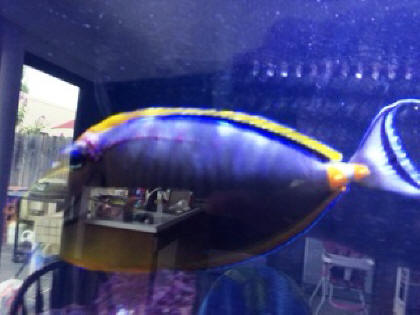 |
|
Naso Tang discoloration, loss
1/28/14
Good Morning Mr. Fenner :)
<Tomasz>
How are You?
<Fine; thank you>
Long time since I wrote to you.
I have two questions.
First one - in annex i send photo Naso tang with some strange white spot
on her belly. What is this?
<Either natural coloration (a lack thereof), or evidence of some sort/s
of stress.>
Some bacteria, parasite or maybe something else.
<Something else; not pathogenic. Time going by, good conditions,
nutrition will find this area coloring up>
This is not the first fish who looks like this.
I do not understand, swims 2 months or longer and on the next day he
died and it looks like the picture.
Can You tell what it is?
<Again: "Stress"... something, perhaps some one in the system
bothering it... Could it have been stung by a Cnidarian/"Coral"?>
Second question is, can You tell me how distinguish sex in the
Moorish Idol ?
<Only when I see them in pairs or groups... males are slightly larger,
more pointed unpaired fins... Otherwise; just looking at individuals, or
immature specimens... could be either>
I would like to keep them in pairs.
<Not easily done; but then again; not impossible. Look for "Coral"
magazine in what language/s you understand best (Deutschen, Italiano,
English) for some very nice articles written on Zanclus husbandry a few
years back>
Thanks my Friend for the advice.
Tomasz
<Cheers, Bob Fenner>
|
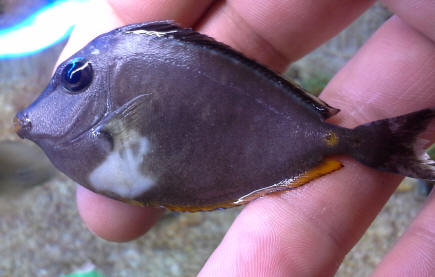 |
|
Asymmetric white streaks on new blonde Naso.
2/6/13
Hi WWM crew,
I purchased an apparently healthy blonde Naso one week ago.
After a few days in hiding in the QT
<Shouldn't hide... but need large volumes... likely damaged itself>
he comes out to eat Mysis, Nori, and gel food. Yesterday I noticed
some white streaking on his left side. I am somewhat sure
that it is not stress markings, due to the asymmetry of the marks,
although I have also noticed some stress marking at times as well.
I tried to take some photos which I have attached. Although they
are a bit blurry (tangs swim fast!)
the markings can be made out in the photos. They are not raised, as far
as I can tell.
I have checked out the disease sections on your site, and I cannot
determine what this might be. Any ideas? Does this fish
require treatment of some sort?
Thank you for your help!
Bruce
<No treatment, as injuries are the cause here and med.s will only
compromise water quality. I'd move this fish dip/bathing it, to the
main/display tank. See WWM re dips/baths. Bob Fenner>
|
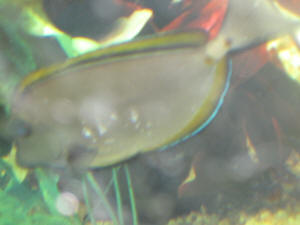
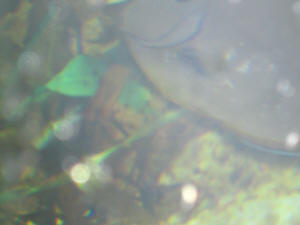 |
|
Black mark on Naso tang?
Hello crew!
<Hi there Terry>
I have a Naso tang which has a mark on his side which looks like
a permanent marker,
<Good description>
I know it is not Paravortex, and none of my other fish have any
spots, tank pars are normal, it is a 150 FOWLR. I was wondering
if it may be from being stung by the Foxface?
<Mmm, not likely this sort of mark...>
He seems normal, and eating well but if this is a disease I would
like to get a jump start on it, this is the best pic. I could
get.
Thanks in advance,
Terry
<Have seen these sort of blems many times... Are bruises of
sorts... usually clear themselves up over weeks to month's
time. No "treatment" suggested other than good care.
Cheers, Bob Fenner>
|
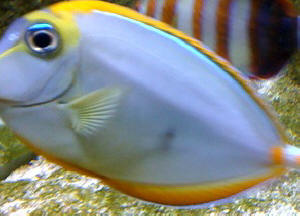 |
|
Blonde Naso Tang - ill/mouth 7/5/09
Good evening & Happy 4th of July,
<Now the morrow of the 6th... glad I stayed home with the
dogs>
I just upgraded my tank to a 150 gallon Elos XL120 tank... plenty
of live rock and coral.
I bought a Blonde Naso Tang... he had only been at the LFS for
24hr when I bought him.
<Mmm... two sides to an/the argument whether to leave such
fishes/species longer or no>
It's been 36hr since I got him home, and he hides under a
rock,
<Bad behavior>
is breathing quickly and today has developed a white fungus-like
material around his mouth.
<I see this in your pic>
I've searched Google and your site for help... any advice
would be much appreciated. I've also included a photo.
Thanks,
Zach
<Either has been "running" (more like swimming) into
rock, the aquarium sides... or something is brutalizing it in
your system... We could/might bandy back and forth re what else
is in your system, water quality,
history... but instead; read here:
http://wetwebmedia.com/nasoldis.htm
and the linked files above. Bob Fenner>
|
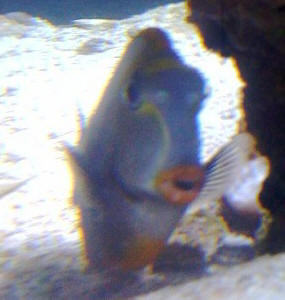 |
|
Re: Blonde Naso Tang - ill/mouth -
7/6/09
Hey Bob,
<Zach>
Thanks so much for your quick response.
<Certainly welcome>
The water parameters are all in great shape. The Blonde Naso is
one of the first fish I added to the tank. All of the other fish
are doing great and nobody has been terrorizing him at all.
Mostly I just have peaceful wrasses in with him. Once I added him
to the tank he instantly hid behind a rock and has pretty much
stayed back there.
<Mmm, frightened perhaps>
I called the LFS and they were very defensive about the condition
of the fish, saying the white stuff wasn't around his mouth
when they sold him to me.
<Likely not, but... why be defensive?>
But, it developed almost instantly and they had only had him 24
hours. Right now I'm just interested in saving this poor fish
as he hasn't eaten in 3 days and doesn't look well.
I've been dosing all food with garlic hoping this might help
his appetite. Can you think of any treatments I should try? Maybe
PraziPro?
Thanks again!
-Zach
<I would NOT treat this fish with "medicine/s"...
What temperature is the water? What nitrogenous waste levels
present? What re dissolved oxygen and ways to increase it? Do you
have another established system of size you could move this fish
to? I will stand by my previous speculation and say it likely
"bumped" into something/s... and the "owees"
on its face are resultant, leading to the poor behavior (is the
tank area very dark at night?)... BobF>
Re: Blonde Naso Tang - ill/mouth -
7/7/09
Wow, 2 responses from you. Wonderful! And thank you.
<Welcome>
Unfortunately my old tank is no longer around to transfer the
Blond Naso to. All of the rock in my new tank has been
established for years and I've yet to lose a fish (I bet you
hear that all the time. hah).
Temperature is a solid 78-79 degrees. Nitrates are <5. The ORP
is usually between 275-300.
<A bit low, but fine>
The tank is dark at night--I don't have a moonlight.
<Mmm, is it "so" dark... from there being no other
light in the surrounding outside room that the fishes might be
inclined to dash into the rock? The markings on the face of the
fish look so much like damage from such, or a
bristle worm>
Seems like your bump theory is a good one. I've never really
considered the moonlight anything but a way to watch the fish at
night--so it's interesting (and obvious) to think it could
actually help them see as well. Duh. I definitely won't treat
the tang with any medicines per your advice. Looks like I'll
just have to wait it out, huh? I bought the fish on Friday and
it's now Monday night and he still isn't eating.
<Try some brown algal food, perhaps Spectrum pellets>
Luckily he looks a bit chubby, so hopefully he can hold out a bit
longer. I bought him and 2 other tangs at once to
introduce them together.
<Oh!? What other species?>
I know tangs generally are less aggressive with each other when
introduced that way. If this Blond Naso doesn't
make it, would it be a bad idea to introduce a new one
immediately after in hopes of limiting the territorial stuff
Tangs do?
<Not likely a good idea; unless this system were much
larger... Hundreds of gallons>
Thanks x1,000,000
-Zach
<Welcome in kind. BobF>
Re: Blonde Naso Tang - ill/mouth
7/8/09
Yes, the tank is so dark that there really isn't any other
light seeping in. My old tank has a moonlight, but never really
thought about adding one to this new setup.
<I would at least have "some" light outside the tank
on during the time/s when the lights are all out on the
inside>
The other tangs I added with him were a Powder Blue and a Yellow
Tang. All were introduced together and I've yet to see any
hostility between any of them.
<Not always obvious...>
I've been putting seaweed in dipped in garlic and the other
two fish are eating it like crazy. Unfortunately the Naso
doesn't seem interested in the slightest.
Thanks again! You're a life saver.
<Read here: http://wetwebmedia.com/nasolfdg.htm
and the linked files above. BobF>
|
|
Naso Problems!!!!! 9/19/08 I have
just received a Naso Tang in yesterday and noticed after I had
placed him in the QT this fungus "I am guessing" on the
side of the fish. <Mmm, no, not really> What do you think
it is and what would be the best course of action. Should I do a
freshwater dip with Methylene Blue, Formalin-3, or ParaGuard. Any
suggestion would be greatly appreciated. Brad <This is almost
assuredly "shipping/collecting damage"... As this
specimen looks to be in good shape otherwise, I'd leave it as
is to heal... can be quite quick to do so... a few weeks. Bob
Fenner>
|
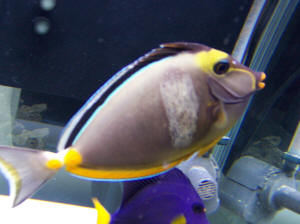 |
| Re: sick tang Hello! <Hi
there> Our Naso Tang has not been acting like himself the last
couple of days. He does not beg for food, or come up to
the front of the tank when we come in the room. He has
not been very active, as well. Today I noticed a
discoloration on his tail juncture (where the tail spines(?) are
located). The only way I can think to describe it is
that it looks like someone spilled ink on the spot. <Agree with
your apt description> I've attached 2 pictures - they are
not very good, but hope that it will help you in diagnosing the
problem. My first instinct tells me to put him in the
quarantine tank with antibiotics - agree? <Actually... I would
leave this fish where it is (in the main/display tank) and boost
its immune system via food (vitamin, HUFA soaking). Bob Fenner>
Thanks is advance! |
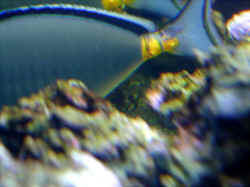 |
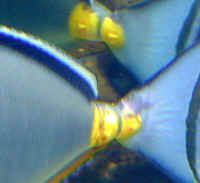 |
Naso Tang with cloudy eyes (more: antibiotic use) Hello all,
I have a customer with a Naso Tang that has stopped feeding and has
cloudy eyes. All of their water parameters look good and this
particular customer is very diligent in maintenance and feeding. I have
never experienced this type of problem and honestly have rarely had to
use antibiotics with any saltwater fish so I would be very appreciative
if you could recommend any antibiotic or other course of treatment.
<May well be that this animal (especially if it is the only one thus
affected in the system) just mechanically injured itself (ran into the
sides, rock)... this happens with Naso tang species (need room)... and
that there is no specific treatment advised, advisable... other than
good maintenance practices, self-healing> Also, if you could
recommend particular antibiotics for treatment of various
"common" bacterial type infections in saltwater fish I would
be grateful. <There are none. Most all infectious diseases of
ornamental aquatics are secondary, tertiary... opportunistic due to
deficiencies in water quality, nutrition, battering by tankmates, the
odd genetic anomaly... some antimicrobials like Furan compounds are
efficacious as adjuncts to improving ones chances in improving
conditions overall... in some cases dips/baths, feeding, injection
(intramuscularly mainly) of antibiotics is something to be suggested...
but the cases are few, specific> In my years of keeping saltwater
fish both as a hobbyist and now an LFS owner I really can't recall
needing to use antibiotics so I feel a bit inept when asked how to
treat these types of problems. <Oh, agreed. This has been my
experience, recollection as well. Bob Fenner> Thanks, Richard
Re: Naso Tang with cloudy eyes (marine antibiotic use) Thank
you for the info. This is essentially what I have been advising so
I'll stick to it. <Me too... have never experienced definitive
proof of antibiotic benefits on a consistent basis... and recent works
(e.g. Ed Noga, and I spoke w/ him re at MACNA XIII re)... other than
expensive broodstock, and mainly trauma (as in spawning) incidents,
direct injection... am of the opinion that such compounds mainly do
"good" by modifying water chemistry (e.g. tetracycline
hydrochloride lowering pH), perhaps reducing TBC's (total bacteria
counts)...> For whatever reason some customers seem to go on the
defensive at the suggestion that they have water quality issues and are
intent on buying something that will magically fix their problems.
<Bingo! Part of the/our "western ethic"... trained by
Madison Ave. to "buy something"... perhaps we can, should
sell "sugar pills"... oh, Weiss has beat us to the
punch...> The typical response is "I know my water is fine
because it's perfectly clear" <To which I typically respond
"so is vinegar"> or the best one yet "I know it's
not my water because I only use Ozarka and it's the best". Ah
well, sometimes there isn't much you can say. <Be yourself,
state what you believe, know, simply. Ask questions like "what if
you used distilled water" or only drank such yourself... ways to
introduce, induce more open-mindedness. Reciprocally, maybe you're
ready, in need of a holiday? Bob Fenner> Thanks again, Richard
| Cause for alarm? (Naso Tang) Hello Bob (or
whoever is filling the shoes today), About 2-1/2 weeks ago, I moved
a Blond Naso into my main tank. After about 5 minutes, the Tang
started darting around the tank (lights off) and smashing into
rocks and the glass. <Not atypical behavior> After
about 45 seconds of this, he settled down, and hid in the darkest
corner he could find. He would venture out every now and then,
sampling the live rock, and all else appeared well. The following
day, the Tang had developed several white "scratches"
about 1mm wide and 4-5mm in length, all running horizontal. I had
pretty much attributed this to the "run-ins" it most
likely had with the various rocks in the tank. <Agreed> The
scratches worsened over the next 3 days, covering the lower and
rear third of its body, and he started to refuse food. None of the
scratches appeared to be open wounds, thankfully. Not noticing any
obvious external parasites, I played the waiting game, and ordered
some Tang Heaven from the folks at IPSF, to coax the Tang into
eating again. After 3 days of not eating, the Tang began to sample
the Tang Heaven, but only consuming some. His stomach started to
fill-in again, which I took as a sign of improvement. The whitish
scratches began to fade, as well as about another third of his
body, and the Tang took on a very light whitish-gray color. I
started to worry about the possibility of an outbreak of velvet,
but chose instead to "wait and see". No further external
signs presented themselves over the next few days. Today, a week
after the introduction of the Tang Heaven, he has started accepting
Selcon-soaked flaked Spirulina again, and constantly grazes on the
Tang Heaven, live rock, snails, etc. I am taking this as a good
sign, but I am not convinced of being 100% out of the woods yet.
None of the other inhabitants show any visibly noticeable signs,
and are acting as they always have. I was wondering if you might
have any suggestions for anything I have overlooked. Obviously, I
refuse to induce any unwarranted stress on the Tang, but I would
hate to lose him to something I might have overlooked. (Picture
attached) And now, for the ever important tank information: 190
gallon, 2x99 DAS filtration units with skimmers. (Changing over to
sump and EuroReef within 2 months). pH 8.3, Ammonia 0, Nitrite 0,
Nitrate 5ppm, Phosphates <.2, Alk 10, Temp 80F. 1100gph and
700gph powerheads for water movement, coupled with the DAS return
pumps (2000L/hr each). 15 gallon water change weekly, plus top-off.
Lighting 2X400W 12000K MH (8 hrs/day) supplemented with 2 NO
Actinics (10 hr/day). Kalkwasser drip to maintain Calcium around
400. 100 pounds live rock (more on the way soon), 40 pounds
aragonite, 120 pounds live sand (more on the way soon, as well).
Other Tank Inhabitants: 1 Chocolate Ocellaris, 1 Red-Lip Blenny, 1
Lawnmower Blenny, 1 Dragon Goby, 1 Scooter Blenny, 2 Engineer
Gobies, 2 Cleaner Shrimp, 2 Peppermint Shrimp, 2 Sand Sifting
Stars, 3 Brittle Stars, 2 Anemone crabs with appear to have hosted
with the 2 flame scallops, 3 Sally Lightfoots, and 4 emerald crabs
who "live" underneath a long tentacle anemone (fed a
whole shrimp twice weekly), 3 dozen assorted snails, a half dozen
scarlet reef hermits, as well as (I know you won't like these)
a cucumber, and a long-spine purple urchin. There, I think
that's everyone. Corals: 3 varieties of mushrooms
(identifying), anthelia polyps, another polyp I am trying to
identify, as they are overtaking one of the rocks, a coral
elegance, a green brain, and a Porites covered in Xmas tree worms.
Feeding done with DTs every other day, coupled with Coral Heaven
for spot-feeding. Thanks again for your assistance, not only for
me, but for all of us in the hobby!-Jim I neglected to include one
parameter in my last email: Salinity: 1.025 -Jim
<Thank you for this detailed report of your success. Your being
patient, observant and pro-active in your food offerings has saved
your Tang. Bob Fenner> |
|

|
Surgeonfishes: Tangs for Marine Aquariums
Diversity, Selection & Care
New eBook on Amazon: Available here
New Print Book on Create Space: Available
here
by Robert (Bob) Fenner |
 |
|
|

